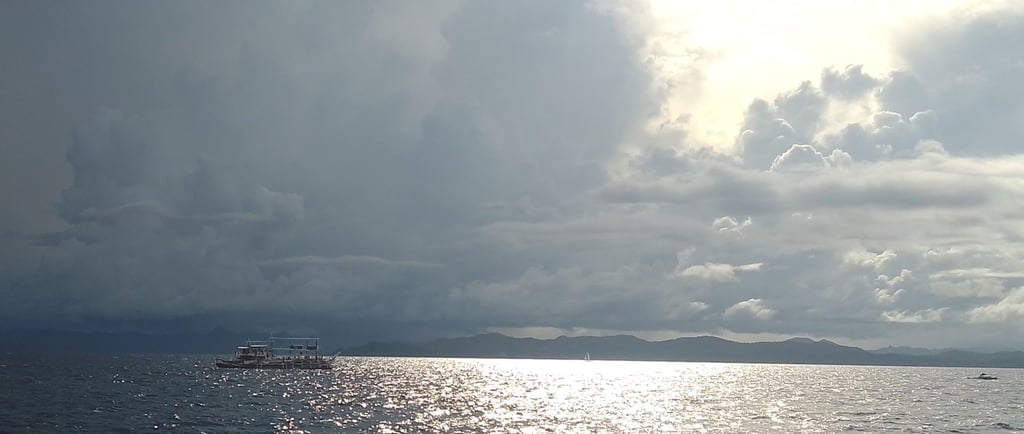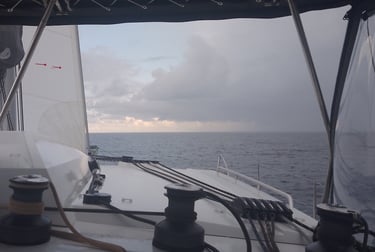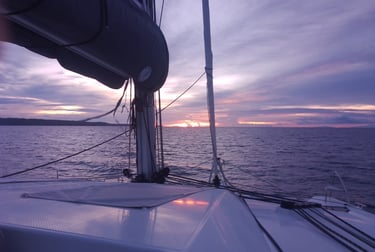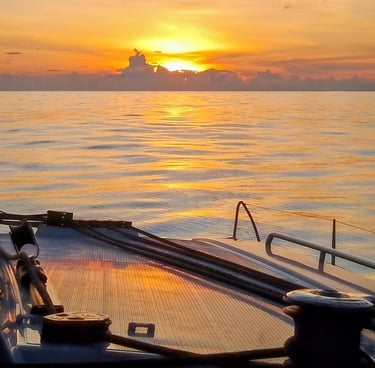The Equatorial Routine: From Calm to Storm to Calm
I share part of the daily cycle of life while sailing near the equator, which is dominated by predictable weather patterns. The routine starts with peaceful sunrises and straightforward sailing, where the intense daytime heat causes moisture to build into towering, anvil-shaped cumulonimbus clouds. Each evening, these clouds deliver a spectacular but tiring "Sleep Tax": a sequence of thunder, lightning, swirling winds, building wave chop, and torrential rain. This nightly disturbance forces us to scramble to close hatches, disrupting our sleep with noise, motion, and stifling heat, only for the weather and cabin to calm again hours later, allowing for a few hours of deep rest before the cycle begins anew with the sunrise.
Jason Haigh
10/27/20252 min read


Sailor’s Routine
Routine, routine, routine: beautiful sunrises and sunsets, with eat, drink and sail in between – then repeat. A pretty good formula for me! (Oh, and occasionally catch a tuna or mahi J)
Sailing at these latitudes (0 – 10 deg North) also means living with the routine of the daily equatorial thunderstorms. Each day begins with an uplifting sunrise, painting swirling patterns across the sky's high moisture. As the sun climbs, the temperature soars. We go through the ritual of closing curtains and maximizing airflow to keep the cabin liveable. The sun’s heat drives the moisture from the sea skyward, forming those long, white clouds aligned over the land. These then build throughout the day into the classic, towering, anvil-shaped cumulonimbus clouds that promise an incredible light show by the evening.


The Sleep Tax
Typically, the thunder and lightning display gives way to a challenging sequence of swirling wind, building wave chop, and several torrential downpours. This is where the cycle gets exhausting. Let me explain, the Sleep Tax; I go off watch at 9 p.m. and usually manage a solid block of sleep until 1 or 2 a.m. That's when I'm woken; by the need to scramble and shut hatches against the deluge and by the boat bouncing around from the building chop. Finally, the rapid increase in heat as the airflow is stifled from closed hatches. The last couple of hours of my off-watch are no longer good sleep, but sweaty, fitful rolling. When Matt goes to his off-watch at 3 a.m., he faces the reverse - 1 or 2 hours of the same punishing sequence before the rain finally stops, the waves calm, and the cabin slowly cools down so that he can get his deep sleep. We also need a nap during the day to catch up another missed hour or so. Then rinse and repeat.


The Fishing Fleet Minefield
Of course, to add to our groggy 3 a.m. state, we have to navigate through the fishing fleet minefield. On passage to Bonbonon port, we passed through a fishing fleet of those tiny outrigger style canoes; most with lights and some without! (I counted over 70 around me – and it didn’t stop for several hours). Also, don’t forget that we may be in a torrential downpour which causes near nil visibility, as well as rendering the radar ineffective (adjusting the radar for rain clutter just filters out the canoes L). Matt and I are looking forward to some open ocean where these little fishing canoes don’t go.






Join Us For Adventure
Check our adventure calendar to join us and experience these amazing places!
Join Us In Adventure
A unique sailing adventure where you get to adjust the passage plan to include places that interest you!
If the weather allows and crew think it's cool then it'll happen.
Connect
info@sailsevenseas.com
+61 406 708002
© 2025. All rights reserved.
